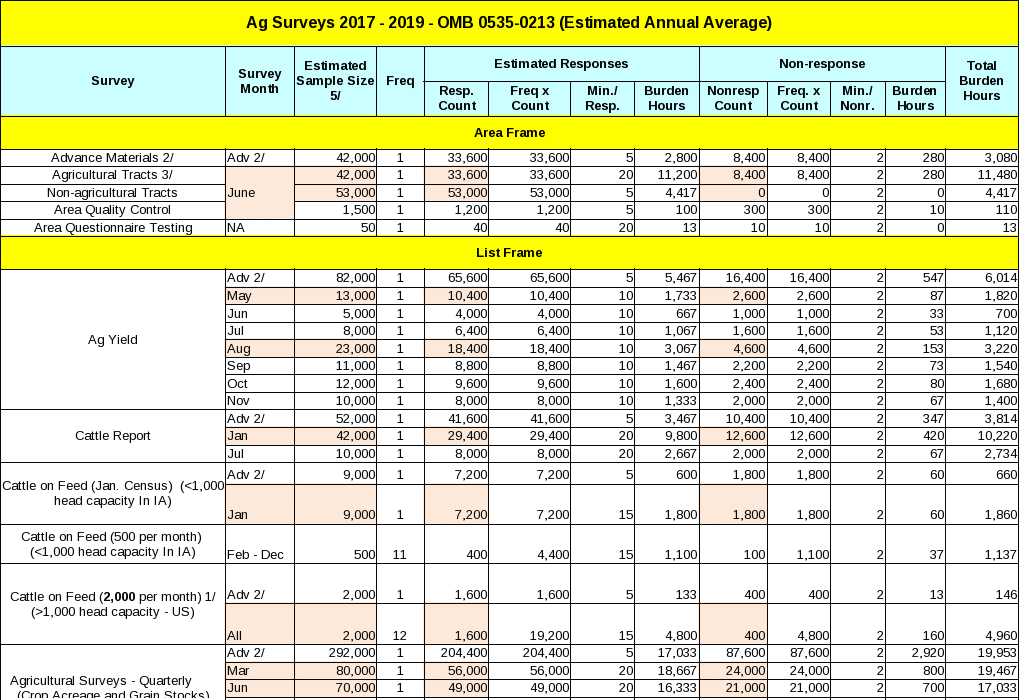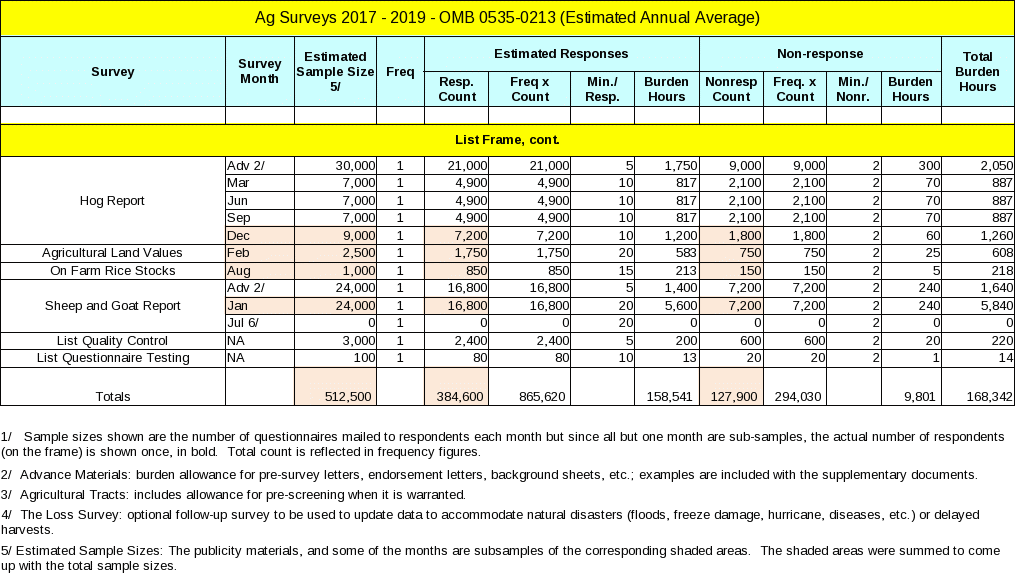0213-ags-2019 - SSA Supplemental Supporting Statement for Substantive Change to Sheep
0213-ags-2019 - SSA Supplemental Supporting Statement for Substantive Change to Sheep.docx
Agricultural Surveys Program
OMB: 0535-0213
1 Supporting Statement – Part A
AGRICULTURAL SURVEYS PROGRAM
OMB No. 0535-0213
This substantive change is being submitted as a supplemental supporting statement to the January Sheep Survey.
A. JUSTIFICATION
1. Explain the circumstances that make the collection of information necessary. Identify any legal or administrative requirements that necessitate the collection. Attach a copy of the appropriate section of each statute and regulation mandating or authorizing the collection of information.
NASS is requesting a substantive change to the January Sheep and Goat survey that will be conducted in January 2020. Through a cooperative agreement between the National Agricultural Statistics Service (NASS) and the Animal, Plant Health Inspection Service (APHIS), NASS will be including additional questions on the January Sheep and Goat Survey. These questions will be addressing predator/loss issues. The majority of the questions that will be added to the January 2020 questionnaire are included in the Master Questionnaire that was included in the original docket that was submitted to OMB for approval in April 2017. In addition there will be a couple of questions that were approved in the previous docket relating to nonlethal predator control methods used on sheep farms. The few new questions that will be added to the survey relate to the movement of sheep from the farm, the use of identification tags on the sheep, the use of government trappers used to control predators and if the operation quit raising sheep, what was the reason.
2. Indicate how, by whom, and for what purpose the information is to be used. Except for a new collection, indicate the actual use the agency has made of the information received from the current collection.
APHIS and other data users will be able to quantify the extent of damages caused to sheep and what sort of controls are being used to prevent or decrease the losses due to predators.
3. Describe whether, and to what extent, the collection of information involves the use of automated, electronic, mechanical, or other technological collection techniques or other forms of information technology, e.g., permitting electronic submission of responses, and the basis for the decision for adopting this means of collection. Also describe any consideration of using information technology to reduce burden.
The questionnaires are available to the respondents by internet, computer assisted telephone and personal interviews in addition to the traditional paper versions.
4. Efforts to identify duplication.
There are no changes from the original approval related to duplication reduction.
Methods to minimize burden of small businesses.
NASS incorporated additional screening questions and skip patterns to help minimize additional burden as much as possible.
Consequence if information collection were less frequent.
There are no changes to the frequency of these surveys than was originally approved.
Special circumstances.
No special circumstances are associated with this information collection.
Federal register notice and consultation with outside persons.
Not applicable.
Payments or gifts to respondents.
No payments or gifts will be given to respondents.
Confidentiality provided to respondents.
Confidentiality will be provided to respondents in accordance with the Confidential Information Protection and Statistical Efficiency Act (CIPSEA) of 2002. All confidentially protections that are applied to all products released from these surveys will remain the same as originally approved.
Questions of a sensitive nature.
No questions of sensitive nature will be asked.
12. Provide estimates of the hour burden of the collection of information. The statement should indicate the number of respondents, frequency of response, annual hour burden, and an explanation of how the burden was estimated. If this request for approval covers more than one form, provide separate hour burden estimates for each form and aggregate the hour burdens in Item 13 of OMB Form 83-I. Provide estimates of annualized cost to respondents for the hour burdens for collections of information, identifying and using appropriate wage rate categories.
The following table contains the estimated burden hours for the surveys included in this supplemental supporting statement. Cost to the public for completing the questionnaire is assumed to be comparable to the hourly rate of those requesting the data. The adjusted overall cost to the public is estimated at $6,441,179.28.

NASS uses the Bureau of Labor Statistics’ Occupational Employment Statistics (most recently published on March 29, 2019 for the previous May) to estimate an hourly wage for the burden cost. The May 2018 mean wage for bookkeepers was $20.25. The mean wage for farm managers was $38.43. The mean wage for farm supervisors was $24.42. The mean wage of the three is $27.70. To calculate the fully loaded wage rate (includes allowances for Social Security, insurance, etc.) NASS will add 33% for a total of $36.84 per hour.

13. Provide an estimate of the total annual cost burden to respondents or record-keepers resulting from the collection of information.
There are no capital/start-up or ongoing operation/maintenance costs associated with this information collection.
14. Provide estimates of annualized cost to the Federal government; provide a description of the method used to estimate cost which should include quantification of hours, operational expenses, and any other expense that would not have been incurred without this collection of information.
The cost to the Federal government for the Agricultural Surveys Program is expected to total $30.5 million annually.
15. Explain the reasons for any program changes or adjustments reported in Items 13 or 14 of the OMB Form 83-I (reasons for changes in burden).
In response to a request from APHIS, NASS has agreed to add additional questions to the January Sheep survey in order to allow APHIS the ability to do additional analysis of the effects predators have on US sheep farmers and their flocks. The program change will not impact the sample size it will only impact the amount of respondent burden.

16. For collections of information whose results will be published, outline plans for tabulation and publication. Address any complex analytical techniques that will be used. Provide the time schedule for the entire project, including beginning and ending dates of the collection of information, completion of report, publication dates, and other actions.
Data from the January Sheep and Goat Report are generally released during the last week of January.
http://usda.mannlib.cornell.edu/MannUsda/viewDocumentInfo.do?documentID=1145.
17. If seeking approval to not display the expiration date for OMB approval of the information collection, explain the reasons that display would be inappropriate.
No approval is requested for non-display of the expiration date.
18. Explain each exception to the certification statement identified in Item 19, “Certification for Paperwork Reduction Act Submissions” of OMB Form 83-I.
There are no exceptions to the certification statement.
August 2019
| File Type | application/vnd.openxmlformats-officedocument.wordprocessingml.document |
| Author | hancda |
| File Modified | 0000-00-00 |
| File Created | 2021-01-14 |
© 2025 OMB.report | Privacy Policy

